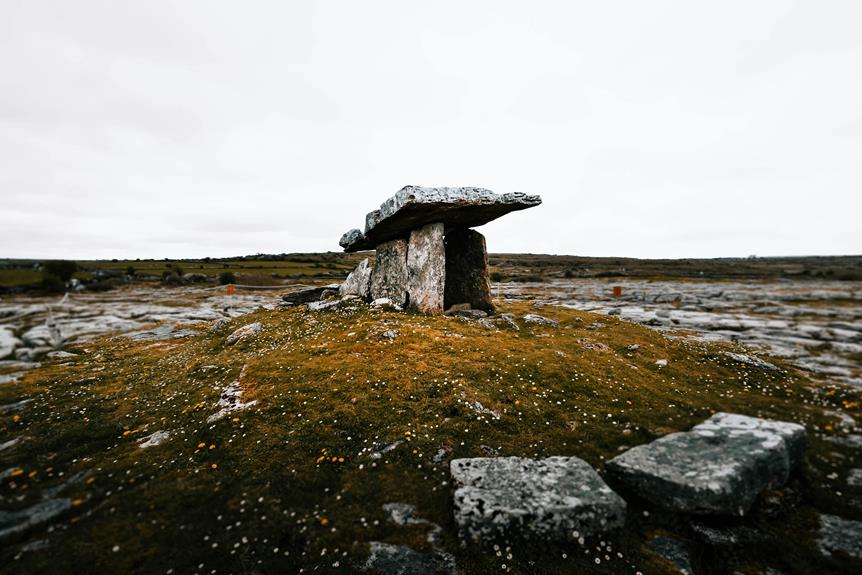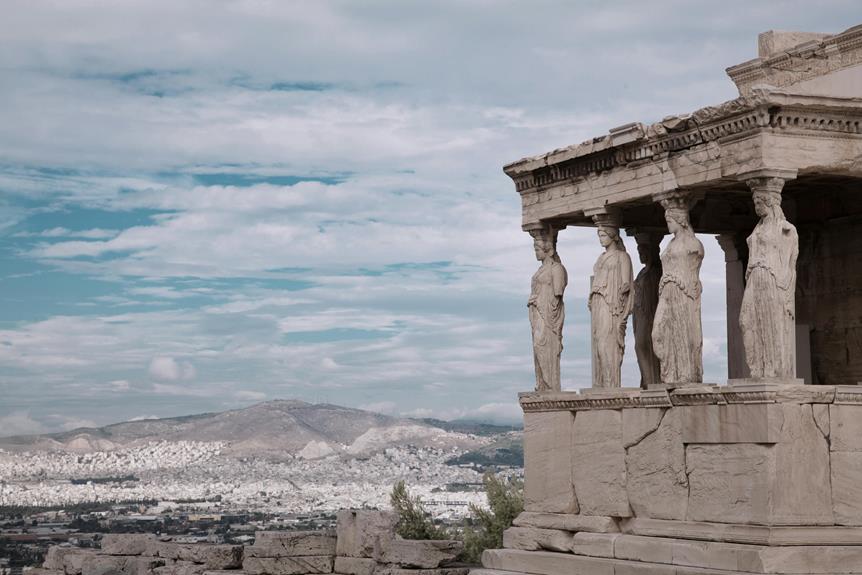The presence of Lenin's Mausoleum in the heart of Moscow serves as a constant reminder of Russia's tumultuous history and the enduring legacy of the Soviet era. Beyond its architectural grandeur lies a complex narrative encompassing political ideology, scientific curiosity, and ethical dilemmas. The embalmed body of Vladimir Lenin within the mausoleum raises profound questions about memory, preservation, and the intersection of politics with historical remembrance. As visitors stand in the shadow of this iconic structure, they are confronted with a tangible link to a bygone era, prompting reflection on the intricate layers of Russia's past and the implications for its future.
Key Takeaways
- Located in Red Square, Moscow, symbolizing Russian Revolution.
- Designed by architect Alexey Shchusev, blending neoclassical and modernist styles.
- Houses Lenin's embalmed body, preserving Bolshevik leader's legacy.
- Popular tourist attraction offering insights into Russia's history.
- Sparks debate on preservation, political symbolism, and cultural significance.
Historical Background
In order to comprehend the significance of Lenin's Mausoleum in Russia, it is important to explore its historical background, tracing its origins and evolution within the broader context of Russian history and politics. The mausoleum, located in Red Square, Moscow, stands as a symbol of the Russian Revolution and the subsequent establishment of the Soviet Union. Following the death of Vladimir Lenin, the leader of the Bolshevik Party and the first head of the Soviet state, in 1924, there was a widespread desire among the Soviet people to preserve his memory.
The decision to embalm Lenin's body and place it on public display was a significant one, as it not only honored Lenin's role in the revolution but also solidified his status as a revered figure in Soviet history. The mausoleum itself was designed by architect Alexey Shchusev and serves as a monumental structure that attracts visitors from around the world.
Throughout the tumultuous periods of Russian history, including World War II and the fall of the Soviet Union, Lenin's Mausoleum has remained a constant presence in Red Square, a testimony to the enduring legacy of the Russian Revolution. It continues to evoke mixed feelings among Russians, symbolizing both the ideals of freedom and the darker chapters of their past.
Embalming Process
Following the decision to embalm Lenin's body and place it on public display at Lenin's Mausoleum in Red Square, Moscow, the embalming process undertaken was a meticulous and scientifically advanced procedure that aimed to preserve his remains for posterity. The embalming techniques used sparked scientific debate and had significant political implications, influencing public opinion.
- Embalming Techniques: The embalming process involved a combination of arterial embalming, cavity embalming, and surface embalming techniques. These methods aimed to slow down the decomposition process and maintain the lifelike appearance of Lenin's body.
- Scientific Debate: The decision to embalm Lenin's body raised ethical questions and sparked scientific debate regarding the long-term preservation of human remains. Scientists and experts continue to discuss the effectiveness and implications of such preservation techniques.
- Political Implications: The embalming of Lenin's body had profound political implications, symbolizing the enduring legacy of the Soviet leader and the Communist ideology. It served as a powerful tool for the Soviet government to maintain control and influence over public opinion.
- Public Opinion: The public's reaction to Lenin's embalmed body was mixed, with some viewing it as a symbol of respect and others critiquing it as a macabre display of power. The display of Lenin's preserved body continues to be a subject of fascination and controversy among visitors to the mausoleum.
Architectural Design
The architectural design of Lenin's Mausoleum in Russia exemplifies a harmonious blend of neoclassical and modernist influences, reflecting the ideological significance of the structure within the historical context of Soviet Russia. The mausoleum's exterior features neoclassical elements such as the red granite walls and the imposing rectangular shape, which symbolize strength and permanence, echoing the grandeur of ancient structures. These neoclassical aspects are complemented by modern influences, visible in the clean lines, minimalist aesthetic, and the use of innovative materials like glass and metal, which imbue the mausoleum with a sense of progress and innovation.
The fusion of neoclassical and modernist elements in the architectural design of Lenin's Mausoleum not only pays homage to traditional Russian architecture but also signifies the Soviet Union's forward-looking ideology. The incorporation of innovative materials reflects the nation's desire to embrace modernity while still respecting its historical roots. The mausoleum stands as an illustration of the changing times, where tradition and innovation coexist in a single structure, mirroring the complexities of Soviet society during Lenin's era.
Controversies Surrounding Preservation
Amidst the legacy of Lenin's Mausoleum in Russia, contentious debates arise regarding the preservation strategies employed to maintain the historical integrity of this iconic structure. The controversies surrounding preservation at Lenin's Mausoleum are multifaceted, encompassing a range of issues that intertwine public opinion and political implications.
Some key points of contention include:
- Public Opinion: The public is divided on whether Lenin's body should continue to be displayed in the mausoleum. While some view it as a symbol of respect and historical significance, others argue that it goes against personal beliefs or is a morbid practice.
- Preservation Techniques: There are debates on the preservation techniques used to maintain Lenin's body. Some critics argue that the embalming process is outdated and disrespectful, while others advocate for the continuation of these methods to uphold tradition.
- Political Implications: The preservation of Lenin's Mausoleum has political undertones, with some seeing it as a symbol of communist ideology and others as a reminder of a controversial past. This raises questions about the government's stance on historical figures and their legacies.
- Cultural Heritage: The mausoleum's preservation also raises concerns about cultural heritage and the importance of preserving historical landmarks. Balancing preservation with modern values and beliefs is a challenge faced by authorities.
- Tourism Impact: The controversy also extends to the tourism industry, with concerns about the ethical implications of showcasing Lenin's body as a tourist attraction. This raises questions about the commodification of history and memory.
Visitor Experience
Public perceptions and interactions with Lenin's Mausoleum in Russia play a pivotal role in shaping the overall visitor experience at this historically significant site. Tourists from around the world visit the mausoleum to pay their respects to Vladimir Lenin, the revolutionary leader of the Bolshevik Party and the first head of the Soviet state. As visitors approach the mausoleum, a sense of solemnity and reverence often envelops them, as they prepare to witness the preserved body of Lenin lying in state.
The visitor experience at Lenin's Mausoleum is unique, as it offers a glimpse into Russia's complex history and the legacy of Lenin himself. Tourists often describe feeling a mix of curiosity, awe, and contemplation as they walk through the somber halls leading to the central chamber where Lenin's body rests. The mausoleum serves as a powerful memorial tribute to Lenin, evoking strong emotions and sparking discussions about his impact on Russian history and the global socialist movement.
For many visitors, the opportunity to see Lenin's embalmed body up close is a once-in-a-lifetime experience that leaves a lasting impression. The mausoleum's significance as a historical and cultural landmark adds depth to the visitor experience, prompting reflection on the complexities of Lenin's ideology and the enduring influence of his revolutionary ideas. Ultimately, the tourist impressions and memorial tributes at Lenin's Mausoleum contribute to a rich and multifaceted visitor experience that is both educational and emotionally impactful.
Cultural Significance
Within the historical and cultural landscape of Russia, Lenin's Mausoleum stands as a symbol of enduring reverence and ideological significance. Since its establishment in 1924, this monumental structure has left a lasting cultural impact on Russian society, serving as a site that embodies both political symbolism and historical memory.
- Preservation of Lenin's Legacy: The Mausoleum plays an essential role in preserving the legacy of Vladimir Lenin, the leader of the Bolshevik Revolution and the first head of the Soviet state. By displaying Lenin's embalmed body, the Mausoleum keeps his memory alive in the hearts of the Russian people.
- Political Symbolism: The Mausoleum serves as a powerful political symbol, representing the ideals of communism and the foundational principles of the Soviet Union. It stands as a physical manifestation of the revolutionary spirit that shaped Russia's history in the 20th century.
- Tourism and Education: As a popular tourist attraction, Lenin's Mausoleum attracts visitors from around the world, offering them a glimpse into Russia's tumultuous past and the legacy of its revolutionary leader. It serves as an educational site, providing insights into the country's political evolution.
- Controversy and Debate: The Mausoleum has sparked controversy and debate regarding the preservation of Lenin's body and the ideological significance of maintaining such a structure in modern-day Russia. It continues to be a subject of contention among historians, politicians, and the general public.
- Cultural Heritage: Lenin's Mausoleum stands as proof of Russia's cultural heritage, reflecting the country's complex history and the enduring influence of its revolutionary past. It remains a symbol of cultural pride and historical significance for many Russians.
Frequently Asked Questions
Is Lenin's Body at the Mausoleum Real or a Wax Figure?
The question regarding the authenticity of Lenin's body at the Mausoleum has sparked historical controversy over the years.
Lenin's legacy and the public fascination with his preserved body have fueled debates about the use of preservation techniques.
The mystery surrounding whether the body is real or a wax figure continues to captivate audiences and underscores the significance of preserving historical figures for future generations to study and admire.
How Often Is Lenin's Body Examined for Preservation Purposes?
Regular examinations of Lenin's body are essential for its preservation. Preservation techniques implemented during these examinations include monitoring temperature, humidity levels, and exposure to light.
Surprisingly, a study conducted by preservation experts revealed that the process of embalming Lenin's body involved a complex combination of chemicals and procedures to maintain its lifelike appearance.
These examinations guarantee that Lenin's body remains in a state of remarkable preservation for future generations to witness.
Are There Any Secret Chambers or Passages Inside the Mausoleum?
When exploring the architectural design of historical structures like mausoleums, it is not uncommon to encounter hidden chambers or passages that add mystery and intrigue to these solemn monuments.
Such features are often integrated into the mausoleum's structure with purpose, whether for symbolic representation, security measures, or functional reasons.
The presence of hidden chambers within a mausoleum can enhance its allure, providing a glimpse into the secrets and complexities of its design and history.
Can Visitors Touch or Get Close to Lenin's Preserved Body?
Visitors' behavior near preserved bodies is a sensitive topic in many cultures. Security measures and restrictions are often in place to guarantee respect and preservation of historical artifacts.
When it comes to photography, guidelines are typically stringent to uphold the sanctity of such sites. Understanding and adhering to these regulations is essential to foster a sense of freedom while visiting these locations.
What Happens to the Flowers Left at Lenin's Mausoleum After They Wither?
Preservation techniques play an essential role in maintaining cultural artifacts and symbols. When flowers left at a mausoleum wither, they are carefully removed and disposed of in a respectful manner. This process guarantees that the site remains clean and presentable, reflecting the significance of the cultural figure it commemorates.
Proper disposal of wilted flowers also contributes to preserving the sanctity and solemnity of the memorial.
Conclusion
In the heart of Red Square, Lenin's Mausoleum stands as a testament to Russia's tumultuous history. The embalming process of Vladimir Lenin's body, the unique architectural design, and the controversies surrounding its preservation all contribute to its cultural significance.
Despite the ethical debates and political symbolism, the mausoleum continues to attract visitors seeking to understand the complex legacy of the Soviet Union. Its presence serves as a reminder of the enduring impact of Lenin's ideology on Russian society.


